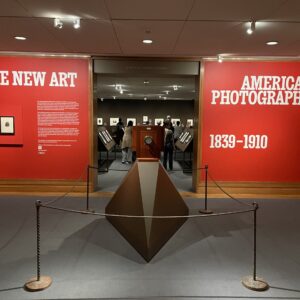JTF (just the facts): A loosely chronological exhibition, covering the years 1958-2019, including over 250 objects (photographs, films, books, and archival materials), installed in a series of rooms on the 3rd floor of the museum, with films shown on the lower level. Organized by Lucy Gallun, with Kaitlin Booher and Casey Li. (Installation shots and film stills below.)
The exhibition is divided into eight sections, as follows:
Section One: The Beginning of Something New
- 11 gelatin silver prints, 1958, sized roughly 14×11, 14×13 inches
- 5 gelatin silver prints, 1958, sized roughly 9×14, 14×11, 16×12, 17×14 inches
- 1 16mm film transferred to video, 1958, 4 minute clip
- 5 gelatin silver prints, 1959, 1961, 1962, sized roughly 9×13, 10×6, 11×14, 13×9 inches
Section Two: The Way These Painters Lived
- John Cohen: 6 gelatin silver prints, 1959, sized roughly 11×14, 14×11 inches
- Robert Frank/Alfred Leslie: 1 16mm to 35mm film transferred to video, 1959, 3 minute clip
- 1 gelatin silver print, 1959, sized roughly 17×12 inches
- 1 gelatin silver print, 1959, sized roughly 11×9 inches
- 1 gelatin silver print with ink in contact printing frame, c1971, sized roughly 17×20 inches
- 1 gelatin silver prints and ink on board, 1985, sized roughly 29×36 inches
- 5 gelatin silver prints, c1954, c1956, 1961, 1962, c1963, sized roughly 16×10, 11×14, 14×11, 14×10, 14×9 inches
- 1 gelatin silver print, 1962, sized roughly 19×15 inches
- vitrine: 2 gelatin silver prints, 1959, sized roughly 14×11; 1 photobook, 1959; 2 record covers, 1960, 1962; 2 magazine spreads, 1961, 1962
- 2 gelatin silver prints, c1960, sized roughly 11×14 inches
- 3 gelatin silver prints, 1955, 1962, 1988, sized roughly 11×14, 10×14, 11×17 inches
Section Three: The Truth is Somewhere Between the Documentary and the Fictional
- 1 gelatin silver print, 1968, sized roughly 14×11 inches
- 2 gelatin silver prints, 1967, sized roughly 11×11, 11×12 inches
- 1 storyboard, c1968
- 1 video (color, sound), 1964, 11 minutes 50 seconds
- 1 gelatin silver print, 1966, sized roughly 11×14 inches
- Allen Ginsberg: 1 gelatin silver print, 1984, sized roughly 11×14 inches
- vitrine: 1 typewritten document, c1964; 1 typewritten document in binder c1964; 1 paper bound in folder, 1984; 1 record cover, 1983
- 1 gelatin silver print, 1969, sized roughly 11×11 inches
- 1 16mm film transferred to video, 1969, 2 minute clip
- 1 gelatin silver print, 1969, sized roughly 10×11 inches
- Danny Lyon: 1 gelatin silver print, 1969, sized roughly 16×20 inches
- 1 16mm film transferred to video, 1972, 6 minute clip
- vitrine: 1 magazine spread, 1974; 1 magazine cover, 1981; 1 gelatin silver print, 1967, sized roughly 10×8 inches; Conrad Rooks: 2 chromogenic prints, 1967, sized roughly 10×12 inches; Danny Seymour: 1 photobook, 1971
- 1 Super 8 film transferred to video, 1971, 2 minute clip
- 2 gelatin silver prints, 1972, sized roughly 8×10, 20×16 inches
- 1 pair of gelatin silver prints, 1972, sized roughly 10×27 inches overall
- vitrine: 11 gelatin silver prints (contact sheets of Super 8 film), 1972, sized roughly 4×9, 5×9, 10×8, 11×9, 6×9, 10×3, 2×3, 5×3, 11×3, 11×14 inches; 2 record covers, 1972
- 1 16mm film transferred to video, 1971, 2 minute clip
- 1 gelatin silver print, 1971, sized roughly 16×20 inches
Section Four: The Lines of My Hand
- 1 16mm film transferred to video, 1972, 2 minute clip
- 6 gelatin silver prints, 1949, 1951, 1951/1976, 1955, 1959, sized roughly 8×12, 9×13, 9×14, 11×14 inches
- vitrine: 2 letters, 1971; June Leaf: 1 gouache and ink on paper, c1972, sized roughly 12×17 inches; June Leaf: 1 charcoal on paper, c1972, sized roughly 18×14 inches; 1 book maquette, c1971; 1 photobook, 1972; 1 photobook, 1972; 1 book maquette, c1989; 1 book maquette, c1989
- 1 gelatin silver print, 1959, sized roughly 12×8 inches
- 1 gelatin silver print, c1968, sized roughly 14×11 inches
- 1 set of two gelatin silver prints, 1966, each sized roughly 20×16 inches
- 1 gelatin silver prints on paper with tape, 1971, sized roughly 21×25 inches
Section Five: In Front of Me I Have the Sea
- Walker Evans: 2 gelatin silver prints, 1971, sized roughly 14×11, 8×8 inches
- 2 16mm films transferred to video, c1975, 1 minute clip, 3 minute clip
- 4 gelatin silver prints, 1971, 1974, 1977, sized roughly 11×14, 8×19, 10×12, 9×10 inches
- 1 gelatin silver prints and ink in contact printing frame, 1971-1972, sized roughly 19×23 overall
- 1 chromogenic prints, ink, and gouache on board, 1976-1977, sized roughly 6×28 inches
- 1 chromogenic prints and ink on board, 1976-1977, sized roughly 12×21 inches
- 2 chromogenic prints, gelatin silver prints, and typed letters on board, 1976, 1976-1977, sized roughly 14×12, 24×18 inches
- 1 gelatin silver prints in contact printing frame, c1977, sized roughly 53×15 inches
- 2 gelatin silver prints, 1975, 1978, sized roughly 11×14, 14×11 inches
- June Leaf: 1 acrylic, gelatin silver prints, and ink on paper, 1973, sized roughly 22×28 inches; 1 acrylic and black-and-white instant prints on paper, 1973, sized roughly 16x 24 inches; 1 acrylic, color instant prints, and thread on paper, 1973, sized roughly 22×12 inches; 1 acrylic, ink, and color instant print on paper, 1972, sized roughly 23×29 inches; 1 acrylic, ink, and color instant print on paper, 1973, sized roughly 11×17 inches; 1 acrylic and ink on board, c1975, sized 30×34 inches; 1 ink, graphite, and acrylic on paper, 1975, sized roughly 18×24 inches; 1 acrylic, ink, and cut-and-pasted paper on paper, c1970, sized roughly 19×27 inches
- 4 gelatin silver prints, 1977, 1978, 1979, sized roughly 24×20, 22×13, 24×15 inches
- 1 16mm film transferred to video, 1980, 4 minute clip
- vitrine: 1 album with text, gelatin silver prints, black and white instant prints, and chromogenic prints, c1977; 1 album of black and white instant prints, gelatin silver prints, and chromogenic prints, c1977; 1 gelatin silver print, c1975, sized roughly 5×7 inches; 1 gelatin silver print and ink, c1970, sized roughly 6×12 inches; 1 book maquette, c1977; 1 gelatin silver print, c1978, sized roughly 14×11 inches
- 1 gelatin silver prints and ink on paper, 1975, sized roughly 11×14 inches
- 1 set of 8 gelatin silver prints, 1977, sized roughly 20×31 inches overall
Section Six: There Are Ways of Strengthening the Feeling
- 1 gelatin silver print, 1973, sized roughly 19×16 inches
- 1 16mm film transferred to video, 1982 3 minute clip
- 1 photobook, 1987
- 2 gelatin silver prints, 1980, 1981, sized roughly 16×20 inches
- 2 gelatin silver prints, 1978, 1979, sized roughly 20×14, 20×16 inches
- 1 diptych of gelatin silver prints, 1979, each sized roughly 24×20 inches
- 2 gelatin silver prints, 1981, sized roughly 14×11, 19×13 inches
Section Seven: The Video Camera is Like a Pencil
- 1 gelatin silver print, 1994, sized roughly 24×20 inches
- 2 gelatin silver prints, 1987, 1989, sized roughly 14×11, 20×16 inches
- 1 set of 5 color instant prints and paint, 1985, each sized roughly 22×26 inches
- 1 set of 6 color instant prints and paint, 1985, each sized roughly 28×22 inches
- 1 photolithograph, 1983, sized roughly 23×18 inches
- 1 set of 3 gelatin silver prints, 1984, each sized roughly 20×16 inches
- 1 gelatin silver print, 1998, sized roughly 18×13 inches
- 1 video, 1989, 3 minutes
- 1 video, 1996, 4 minutes
- vitrine: 1 vinyl record, 1984; 1 vinyl record, 1985; 2 gelatin silver prints, 1987, each sized 5×7 inches; 1 book maquette, 1985; William S. Johnson: 3 gelatin silver prints, 1985, each sized roughly 4×5 inches (or the reverse); 1 letter, 1989
Section Eight: Memory Helps You – Like Stones in a River Help You to Reach the Shore
- 1 gelatin silver prints, color instant prints, and enamel paint, 1992, sized roughly 20×48 inches overall
- 1 gelatin silver prints, 1996, sized roughly 16×37 inches
- 1 gelatin silver prints, 1999-2000, sized roughly 40×48 inches
- 1 gelatin silver print, 1991, sized roughly 23×20 inches
- 1 gelatin silver prints, 1987, sized roughly 48×23 inches
- 5 gelatin silver prints, 1993, 1995, 1998, 2002, 2004, sized roughly 13×20, 12×19, 11×14, 16×20 inches
- vitrine: 1 maquette, 1991; 1 maquette, 1999-2000; 1 maquette, c1995-1997; 1 maquette, 1992; 1 maquette, c2016; 1 photobook, 2016; 1 maquette, c2009; 1 photobook, 2009; selection of black-and-white and color instant prints, c1970-2000, dimensions variable
- 2 gelatin silver prints, 1995, 2005, sized roughly 20×16 inches
- 1 Super8 film transferred to video, 1996, 5 minute clip
- 1 gelatin silver print, 1994-1995, sized roughly 16×20 inches
- 1 gelatin silver print with ink, 1998, sized roughly 16×20 inches
- 2 gelatin silver prints, 1995, 1996, sized roughly 20×16, 20×26 inches
- 1 gelatin silver print in contact printing frame, 1979, sized roughly 12×16 inches
- June Leaf: 1 acrylic on board, 1975, sized roughly 19×29 inches
- 1 gelatin silver print, 1996, sized roughly 15×18 inches
- vitrine: 1 photobook, 2019; 1 maquette, c2019; 5 gelatin silver prints, 2019, sized roughly 12×9, 9×12 inches; 1 gelatin silver prints on metal, c1996, sized roughly 18×24 inches
Robert Frank’s Scrapbook Footage
- Alex Bingham/Laura Israel: Super 8 film transferred to HD video, 1971, 1 minute 41 seconds
- Alex Bingham/Laura Israel: Super 8 film transferred to HD video, 1971, 1 minute 38 seconds
- Alex Bingham/Laura Israel: Super 8m, 16mm film, and video transferred to HD video (six channel projection), 1970-2006, 10 minutes
A catalog has been published by the museum to coincide with the exhibition (here). (Cover shot below.)
Comments/Context: This multi-decade exhibition of the work of Robert Frank is one of the most artistically uneasy and downright restless shows I’ve seen in a long time. What it quietly declares is that living the life of an artist is an unyielding process of creative searching, and that no amount of external validation or “success” (whatever that might mean) will really dilute that fundamental internal impulse in those that feel it strongly.
For Frank, a Swiss-born photographer who came to the United States in 1947, his first decade in America proved to be a step-wise catapult to photographic fame, with early commercial work paying the bills until Guggenheim fellowships funded roadtrips across the country that ultimately culminated in the publication of The Americans in 1958, his now classic (and still broadly influential) outsider’s portrait of mid-century America.
But Frank quickly realized that the hagiographic veneration of The Americans was potentially dangerously constraining to his ongoing development as an artist. Like a rock band forced to mindlessly play the greatest hits over and over, Frank felt like The Americans was an artistic end point (not a beginning), and later worried that he would be asked to endlessly print “tuba players” (one of the signature images from the project captures a man playing a tuba), or even worse, to “make pictures that look like little tuba players.” With surprisingly clear eyes, he saw the curse of success for what it was, and essentially decided to leave it all behind and escape to new artistic pastures.
This wide ranging exhibition picks up Frank’s story just after that risky break, and chronologically follows his eccentrically winding artistic trajectory for the next six decades, until his death in 2019. And for many visitors to this show, this second lifetime of lesser-known artistic output will feel altogether puzzling and even mystifying, mostly because it doesn’t neatly line up behind The Americans in some succinct and obvious aesthetic progression – instead, it wanders with messy and unruly abandon, the artist constantly testing and experimenting with mediums, forms, words, and approaches to visual dialogue that might somehow help him to communicate some of what he was feeling. As a body of work, it courageously grasps for human honesty and authenticity, and is steeped in more than its fair share of personal trauma, sadness, and loss.
Even though Frank did have a show at MoMA in 1962 (a paired exhibit with Harry Callahan), he was already on his way somewhere else artistically by then, largely leaving his still camera behind and turning his attention to film. Photographically, he made some shots out of the public bus running down Fifth Avenue in New York City, and took portraits of various artists and poets in their studios, seemingly more interested in how they lived (and their struggles) than in documenting anything they created, but these single images from the late 1950s quickly gave way to groups, sequences, collages, contact sheets, and combinations of pictures, and more cinematic experiments and collaborations. The first few sections of this show are sprinkled with film clips, from home movies made on the beaches of Provincetown in the summer to more fully realized artistic statements like the improvisational “Pull My Daisy” (a film he made with the painter Alfred Leslie, with a voiceover by Jack Kerouac), with collaborations with Allen Ginsberg, Danny Lyon, the Rolling Stones, and others keeping him busy reinventing his approach to visual storytelling onward through much of the 1960s.
If the first fracture in Frank’s career came with his intentional rejection of the artistic aftermath of The Americans, the second came at the end of the 1960s, with a string of personal changes – his separation/divorce from his first wife Mary in 1969, his move to the blustery seaside community of Mabou in Cape Breton Island, Nova Scotia in Canada, and his remarriage to the painter/sculptor June Leaf in the early 1970s. With the stuttering multi-image thinking of cinematic storyboards and film strips clearly still in his head, Frank returned to photography, making both the rhythms of his relatively simple life in Mabou and his isolating turn inward to face himself more fully his consistent subjects. Gone was any semblance of urban or city subject matter or influence, to be replaced by sweepingly desolate views of the sea, makeshift constructions in his yard, and more intimate and reclusive scenes of the interior of his small fisherman’s shack.
Frank’s early 1970s output is remarkably exploratory, fundamentally breaking down the idea of the legitimacy and veracity of a single image. He makes multi-image composite views of the landscape, layering prints (sometimes color, sometimes black-and-white, often instant or machine-made) on top of one another with tape. He hangs prints on his clothesline and rephotographs the sequential arrangements fluttering in the wind. He builds dense bulletin board agglomerations of imagery and text and rephotographs them both inside and outside. He arranges prints in wooden contact printing frames, giving them a more sculptural quality. And he begins to include more text in his assemblages, including hand-scrawled words and phrases (both in the negatives and on the prints) and typed associations. There are pictures within pictures, reflections with mirrors, and any number of other deconstructive and layering impulses allowed to run free.
But the mid-1970s also held personal tragedy for Frank, in the double blow of the disappearance of his collaborator Danny Seymour in 1973, followed soon by the death of his daughter Andrea, who was killed in a plane crash in Guatemala in 1974. And it is at this point that all of the formal artistic invention and innovation of the previous few years gets turned inward by Frank. Personal grief, loss, sadness, suffering, despair, melancholy, and even bitterness flood into Frank’s output, where they reside for much of the rest of Frank’s artistic career, amplified once again in the mid 1990s by the suicide of his son Pablo, who had suffered from schizophrenia.
As Frank processes his grief, many of the visual subjects remain the same, but stylistically, his mood becomes much more diaristic and unsettled. Views of the sea at Mabou become more desolate and bleak, with darker clouds, rougher waves, windier blown grasses, and more persistent grey days. Out in the yard, he builds sparsely sculptural totems to his daughter out of stacked tree stumps, which he then photographs. Inside the house, darkness rules more fully, with shadowy corners and contrasty looks outward from the windows matched by nostalgic looks at small memory-triggering objects scattered around the rooms. And throughout, Frank’s words become more prominent, incised on the prints with crude anguish and grim resignation, with phrases like “look out for hope”, “keep busy”, “hold still-keep going”, “be happy”, sick of goodby’s”, and “fear-no fear” delivered almost like personal exhortations or encouraging messages-to-self. His previous efforts to brashly disassemble the photographic medium have now been softened and channeled into capturing his shifting moods, leading to works that are far more raw and emotionally charged.
As the years continue to pass, Frank moves further and further toward this deeply felt autobiographical mode of working, making diaristic images of one kind or another and then arranging them in groups of prints, albums, book maquettes, and other intimate forms of sharing. While the wounds and ruptures in his life don’t necessarily heal, he seems to find a sense of calmness in exploring his memories and the broader changes in his life – he photographically wrestles with his demons, and seems to hope that by exposing his interior thoughts and emotions, his response might be meaningful to others.
Over time, his works become more like loose vignettes or impressions, where the views of his home and its contents are filled with the memories of his loved ones and the richness of his enduring care for them. Most of the rooms remain empty and echoing, aside from a few souvenirs here and there, but there is strong sense of presence and attachment nonetheless, and of Frank paying homage to what he has lost. In a certain sense, every one of these later works is a self-portrait, in one form or another, with many of the truncated written, painted, and scratched words and phrases that decorate the compositions largely addressed to himself, almost like film storyboards with inner dialogues and confessions captured as subtitles.
The last room or two of this exhibit wander through these later expressions without much in the way of progression – the photographic ideas are refined and reimagined, but the personal suffering is mostly the same, as slowly muted by the silent passing of time. The artist’s own mortality inhabits many of the last works, with cancer diagnoses, the death of friends, and other accumulated losses hovering in the shadows as the views out the window become more tunnel-like. These works feel altogether elegiac, consistently delivered with an honesty and humanity that is mostly unadorned.
In contrast to a contemporary art world increasingly filled with blandly decorative objects that we can consume without thinking, Frank’s post-Americans works offer an unexpectedly raw nerve, almost too jangly and personal to engage with without some of his trauma rubbing off. The show is a poignant story of an artist initially trying to escape his own fame, who then ultimately turns inward to negotiate peace with himself by exploring the searing pain of his own troubled existence. At the core of this journey seems to lie an urgent need to communicate, and to restlessly experiment with artistic ways to express his changing mental state. What I find most profound about this body of work is how tangled, tortuous, and instinctual it is – as the years pass, Frank is less and less guarded, inviting us inside his mind to reveal the memories that haunt him. He’s willing to show us his face in the mirror, both literally and metaphorically, even when that visage can’t hide from itself.
Collector’s POV: The estate of Robert Frank is represented by Pace Gallery, which is hosting a gallery show of works from roughly the same time period as this exhibition (here, on view between November 15 and December 21, 2024). Frank’s work is routinely available at auction, where recent prices have ranged between $5000 and more than $950000. Key images from The Americans consistently fetch five, and in some cases, six figure prices.
































































































‘Frank’s early 1970s output is remarkably exploratory, fundamentally breaking down the idea of the legitimacy and veracity of a single image.’
In the 80s I struggled to reconcile the change in his practice. He had produced so many outstanding self-contained photographs, each weighted with meaning and feeling, what was he doing? It was like the greatest 100m sprinter in the world suddenly decided to become a roofer – There’s some fab anecdotes out there about him, inluding one where a fan tracks him down in Nova Scotia to find him shirtless, mending his roof. (No offence to roofers, it’s a valued profession.)
So he had been run over by a metaphorical bus, and this messy ‘stuff’ was all he could be summon up. On the back of what came before it commanded attention but for me it was years before I began to figure it was a much more significant contribution than I realised, and can rightly stand alone, regardless of Les Americains.
Glad to see LK gives the full line of stars.